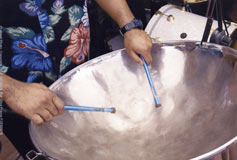

Wednesday - April 11, 2007
SLAC Today is
available online at:
http://today.slac.stanford.edu
In this issue:
LCLS Ice Cream Social This Week
Profile: Jim Panetta's World of Coffee
GLAST Mission One Step Closer to Launch
 |
 |
|
Wednesday - April 11, 2007 |
 LCLS Ice Cream Social This WeekJoin your friends and colleagues on the main lawn this Friday afternoon for the do-not-miss event of spring! Come celebrate the official start of commissioning for the Linac Coherent Light Source (LCLS) with free ice cream from the Palo Alto Creamery and live music from the Island Groove steel drum band. Starting at 2 p.m., SLAC Director Jonathan Dorfan and Director of LCLS Construction John Galayda will kick off the festivities, followed by refreshments served by members of the Directorate. Last week, SLAC physicists and engineers came one step closer to making the LCLS a reality with the first pulse of electrons generated by the injector system. The six-month commissioning process for the first 40 meters of the LCLS is now underway. Come relax and celebrate this exciting achievement! |
||
|
|
||
 Jim Panetta's
|
GLAST Mission One Step Closer to Launch
The next major space observatory, the Gamma-ray Large Area Space Telescope (GLAST), is one step closer to unveiling the mysteries of the high-energy universe. Almost all the components have been assembled onto the spacecraft, which will undergo a review this week before environmental testing begins at the primary contractor, General Dynamics Advanced Information Systems in Gilbert, Ariz. GLAST will study the universe's most extreme objects, observing physical processes far beyond the capabilities of earthbound laboratories. GLAST's main instrument, the Large Area Telescope (LAT)—which was built at SLAC—operates like a particle detector rather than a conventional telescope. It is 30 times more sensitive (and even more at higher energies) than the best previous missions, enabling it to detect thousands of new gamma-ray sources while extending our knowledge of previously unidentified sources. For example, it will study how some black holes accelerate matter to near light speed and perhaps even reveal the nature of dark matter. The other instrument, the GLAST Burst Monitor (GBM), will detect roughly 200 gamma-ray bursts per year. Together with the LAT, the GBM will enable GLAST to make gamma-ray burst observations spanning a factor of a million in energy. "These two instruments and the spacecraft have now been integrated and
are working together as a single observatory," says GLAST project manager Kevin
Grady of NASA's Goddard Space Flight Center, Greenbelt, Md. |
Events (see all | submit)
Access (see all)Announcements
|
| | ||
|
|
||
 <%
Response.AddHeader "Last-modified", getArticleDate()
'Response.AddHeader "Last-modified","Mon, 01 Sep 1997 01:03:33 GMT"
'Monday, December 06, 2010
%>
<%
Response.AddHeader "Last-modified", getArticleDate()
'Response.AddHeader "Last-modified","Mon, 01 Sep 1997 01:03:33 GMT"
'Monday, December 06, 2010
%>View online at http://today.slac.stanford.edu/. |
||